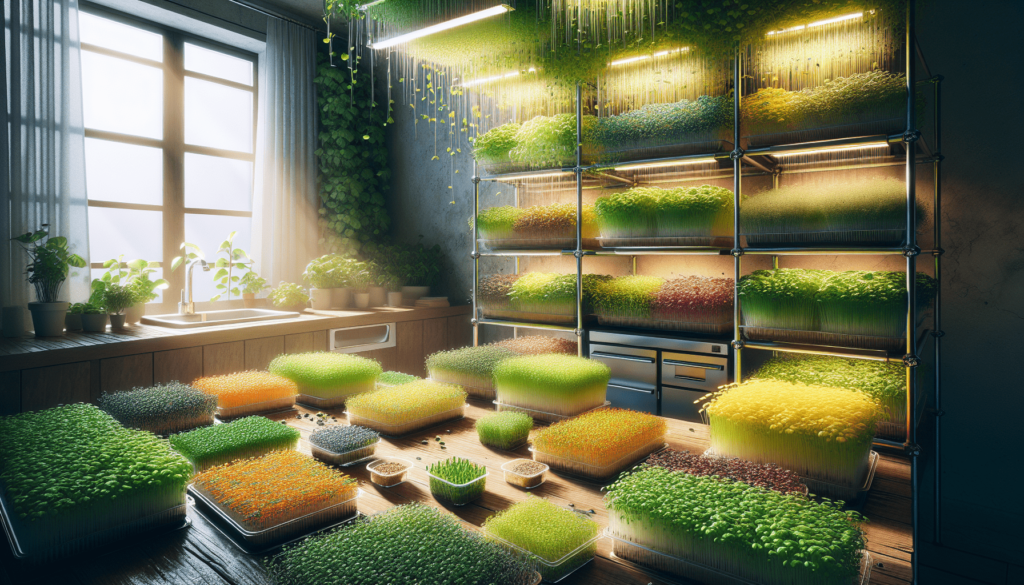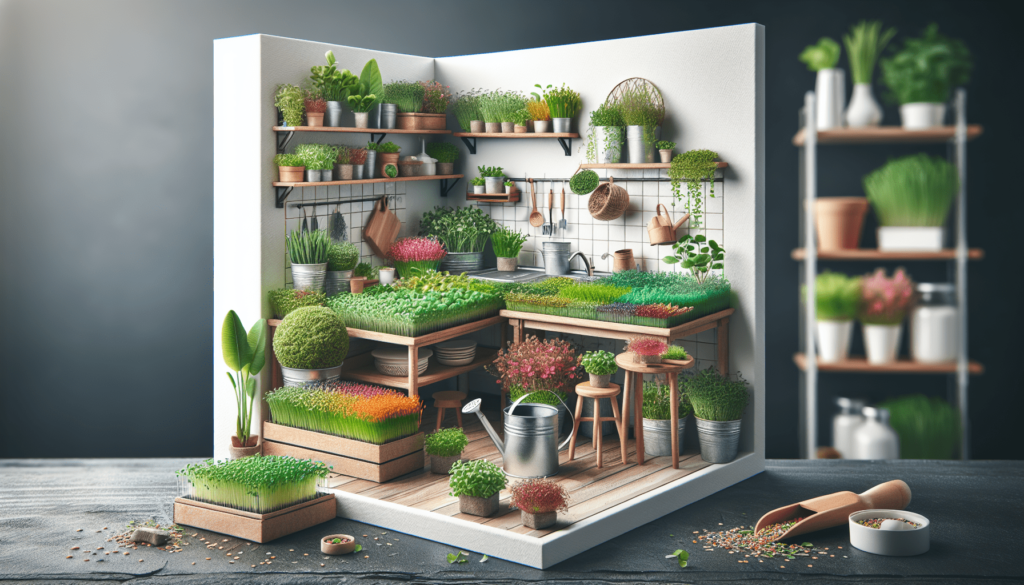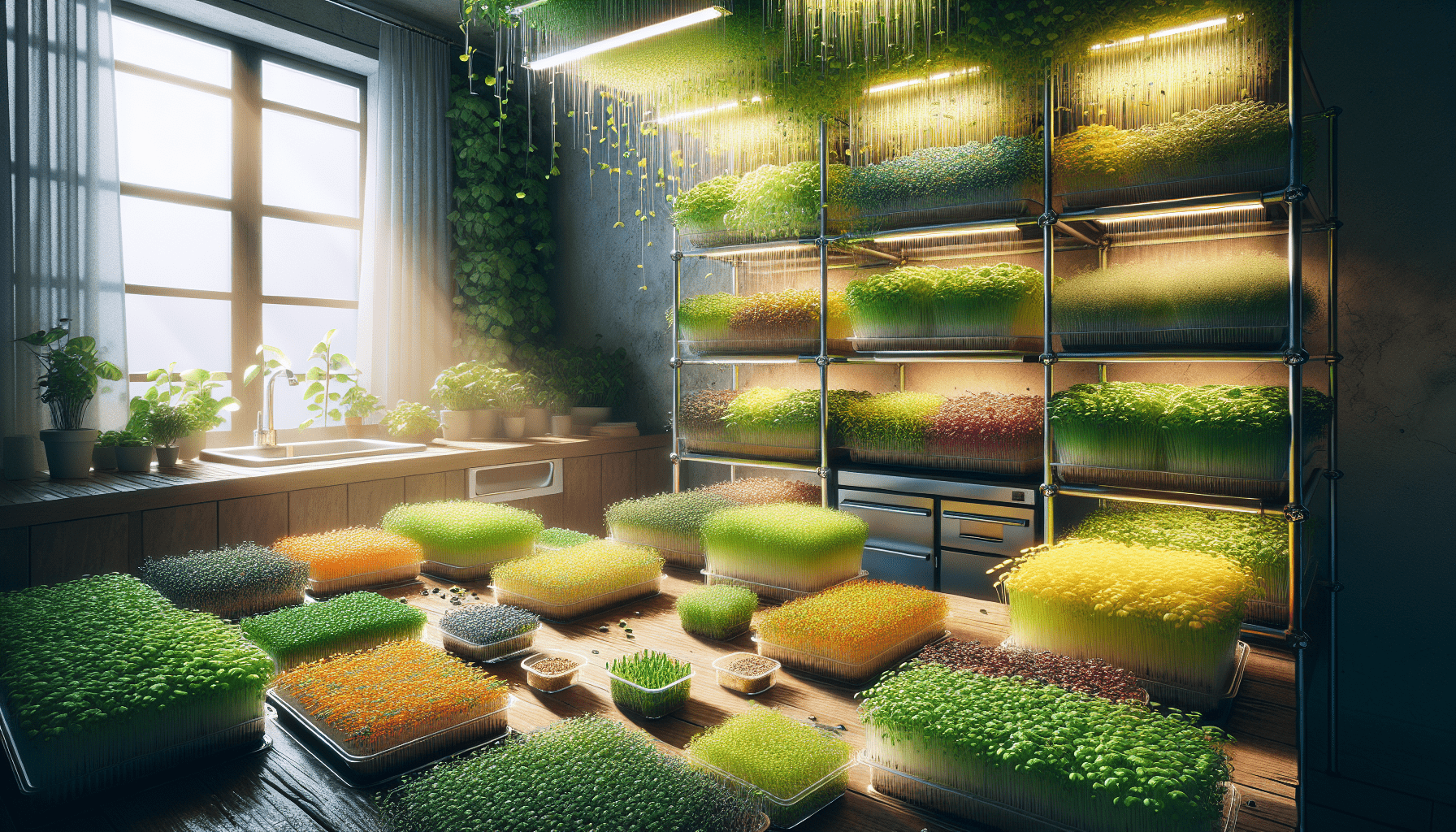Imagine being able to grow your own fresh and nutritious food, even if you have limited space. With the power of microgreens, you can turn your small indoor space into a thriving garden. These tiny and incredibly nutrient-rich plants provide an abundance of flavor and health benefits, all while requiring minimal time and effort. In this article, we will explore the incredible potential of microgreens and how they can revolutionize the way you approach growing your own food. Get ready to discover a world of culinary delights and a greener, healthier lifestyle right at your fingertips.
Benefits of Microgreens
Microgreens are small, immature plants that are harvested at a very early stage, typically within 7-21 days after germination. Despite their small size, microgreens pack a powerful punch when it comes to nutrition. These tiny greens are loaded with vitamins, minerals, and antioxidants, making them a great addition to any diet.
Nutritional Value
Microgreens are often hailed as a superfood due to their high nutritional content. Studies have shown that microgreens can contain up to 40 times more nutrients than their mature counterparts. For example, red cabbage microgreens have been found to have significantly higher levels of vitamin C and vitamin K compared to full-grown red cabbage. Incorporating microgreens into your meals is an easy way to boost your nutrient intake and support overall health.
Short Growth Cycle
One of the major advantages of growing microgreens is their short growth cycle. Unlike many other crops that take months to mature, microgreens can be harvested in just a few weeks. This means you can enjoy the fruits of your labor in a fraction of the time. Whether you have a small backyard garden or limited space indoors, microgreens offer a quick and satisfying harvest.
Easy to Grow
Even if you don’t have a green thumb, you can still successfully grow microgreens. These small plants are relatively low-maintenance and require minimal space and equipment. With just a few simple steps, you can grow your own microgreens right at home. Whether you choose to grow them on a windowsill, balcony, or in a small corner of your kitchen, microgreens are a great option for beginners and seasoned gardeners alike.
Year-round Availability
Another benefit of growing microgreens is their year-round availability. Unlike traditional gardening, which is often limited to specific seasons, microgreens can be grown indoors at any time of the year. This means you can enjoy fresh, homegrown greens regardless of the climate or time of year.
Choosing the Right Microgreens
When it comes to choosing which microgreens to grow, there is a wide range of options available. It’s important to consider both your personal preferences and the specific requirements of each variety.
Popular Varieties
Some of the most popular microgreen varieties include broccoli, radish, sunflower, pea shoots, and kale. Each type of microgreen has its own unique flavor profile and nutritional benefits. Experiment with different varieties to find your favorites and ensure a diverse range of nutrients in your diet.
Consideration of Space and Climate
Before you start growing microgreens, consider the available space and climate in your home. Some microgreens prefer cooler temperatures, while others thrive in warmer conditions. Additionally, think about how much space you have for growing trays or containers. By choosing microgreens that are suited to your specific environment, you’ll increase your chances of success and have a bountiful harvest.

Supplies and Equipment
To start growing microgreens at home, you’ll need a few basic supplies and equipment.
Seeds
The first step in growing microgreens is selecting high-quality seeds. Look for organic, non-GMO seeds specifically labeled for microgreen production. Some popular seed varieties for microgreens include broccoli, radish, sunflower, and cilantro. Remember to choose seeds that match your desired flavor and nutritional requirements.
Growing Medium
Microgreens can be grown in a variety of growing mediums, such as soil, coco coir, or hydroponic mats. Whichever medium you choose, ensure it is sterile and free from contaminants to promote healthy growth. Considerations such as water retention and drainage should also be taken into account.
Trays or Containers
To grow microgreens, you’ll need trays or containers to hold the growing medium and seeds. Many gardeners use shallow trays with drainage holes to prevent waterlogging and promote airflow. These trays can be reused and come in various sizes, allowing you to grow multiple varieties of microgreens simultaneously.
Light Source
Microgreens require adequate light for healthy growth and development. If you don’t have access to sufficient natural daylight, consider investing in a grow light. LED lights are a popular choice due to their energy efficiency and ability to provide the specific light spectrum needed for plant growth. Position the lights to ensure even coverage and adjust the height as the microgreens grow taller.
Preparing the Growing Area
Before planting your microgreens, it’s important to prepare the growing area properly.
Selecting the Location
Choose a location for your microgreen garden that receives adequate light and is away from drafts or extreme temperature fluctuations. A south-facing window or a well-lit spot on a balcony or patio can be ideal. If growing indoors, ensure there is sufficient space for your trays or containers.
Cleaning and Sanitizing
Cleanliness and sanitation are crucial for microgreen production. Ensure all trays, containers, and gardening tools are thoroughly cleaned and sanitized before use. This will prevent the growth of mold or other harmful microorganisms, which could impact the health and growth of your microgreens.
Setting Up the Light Source
If using artificial grow lights, set them up according to the manufacturer’s instructions. Ensure the lights are positioned at the recommended distance from the microgreens to provide optimal lighting. This will help promote healthy and uniform growth throughout the entire growing cycle.

Growing Microgreens
Now that your growing area is prepared, it’s time to start growing your microgreens.
Pre-soaking Seeds
Before sowing the seeds, it can be beneficial to pre-soak them. This helps kickstart the germination process and promotes faster and more uniform growth. Place the seeds in a container and cover them with water for a few hours or overnight. After soaking, drain the water and rinse the seeds before sowing.
Sowing Seeds
Spread the pre-soaked seeds evenly over the prepared growing medium in your trays or containers, ensuring they are not overcrowded. Gently press the seeds into the growing medium but avoid burying them too deep. Each variety may have different recommended seed density, so follow the guidelines provided on the seed packet.
Watering and Humidity
To support healthy growth, water your microgreens appropriately. Use a spray bottle or a gentle watering can to moisten the soil or growing medium without causing any disturbance to the seeds. Maintain a consistent level of moisture throughout the growing cycle, but be careful not to overwater, as this can lead to mold or root rot.
Monitoring Temperature
Microgreens thrive in a stable temperature environment. Avoid exposing them to extreme cold or heat. Aim for a temperature range of around 60-75°F (15-24°C) for optimal growth. Consider using a thermometer to monitor the temperature and make any necessary adjustments to create the ideal growing conditions.
Harvesting
After a few weeks of growth, your microgreens should be ready for harvest. Use a pair of clean scissors or a sharp knife to cut the greens just above the soil level. Harvesting at this stage ensures the microgreens have reached their peak nutritional value and flavor.
Caring for Microgreens
To keep your microgreens thriving, it’s important to provide proper care throughout their growth cycle.
Watering
Consistent and appropriate watering is crucial for healthy microgreen growth. Water your microgreens when the top of the soil or growing medium feels dry to the touch. Avoid overwatering, as it can lead to mold or root rot. Ensure proper drainage in your trays or containers to prevent waterlogging.
Fertilizing
Microgreens typically do not require additional fertilizers during their short growth cycle. The nutrients from the seed and growing medium are usually sufficient. However, if you notice signs of nutrient deficiency, such as yellowing leaves, you can use a diluted organic liquid fertilizer specifically designed for microgreens. Follow the manufacturer’s instructions for proper application.
Pest Control
Microgreens are generally less prone to pests compared to mature plants. However, occasional pest infestations can occur. Keep a close eye on your microgreens and immediately address any signs of pests, such as aphids or fungus gnats. Consider using organic pest control methods or consult with a local gardening expert for effective and safe solutions.
Using Microgreens in the Kitchen
Microgreens not only offer numerous health benefits but also bring a burst of flavor and color to your culinary creations. Their fresh and delicate taste can elevate any dish.
Flavor Profile and Pairings
Each variety of microgreen has its own unique flavor profile. For example, radish microgreens have a spicy kick, while pea shoots have a fresh, sweet taste. Experiment with different combinations to find your favorite flavor pairings. Radish microgreens can add a zesty element to salads or sandwiches, while pea shoots are delicious in stir-fries or as a garnish for soups.
Culinary Applications
Microgreens can be used in a variety of ways in the kitchen. Their tender leaves and vibrant colors make them a visually appealing garnish for any dish. Sprinkle microgreens over salads, sandwiches, omelets, or pizzas for an extra burst of freshness and nutrition. They can also be blended into smoothies or incorporated into dressings, sauces, and pestos for added flavor and nutritional value.
Health Benefits of Microgreens
In addition to their exceptional flavor and versatility in the kitchen, microgreens offer numerous health benefits.
Boosted Nutrient Intake
Microgreens are densely packed with essential vitamins, minerals, and antioxidants. Incorporating them into your diet provides a convenient way to boost your nutrient intake. Vitamin C, vitamin E, beta-carotene, and various phytochemicals are just a few of the vital nutrients found in microgreens. They can help support a strong immune system, healthy vision, and overall well-being.
Reduced Risk of Chronic Diseases
Due to their high concentration of antioxidants, microgreens possess anti-inflammatory and disease-fighting properties. The antioxidants in microgreens help neutralize harmful free radicals in the body, reducing the risk of chronic diseases such as cardiovascular disease, diabetes, and certain types of cancer. Including microgreens in your diet contributes to long-term health and well-being.
Detoxification
Microgreens, particularly cilantro and broccoli microgreens, have been shown to aid in detoxification. Their compounds help support the body’s natural detoxification processes and eliminate harmful toxins. Including these microgreens in your meals can help support a healthy liver and overall detoxification.
Economic and Environmental Benefits
In addition to their nutritional and culinary advantages, microgreens offer economic and environmental benefits.
Reduced Food Waste
Growing your own microgreens allows you to harvest just the amount you need, reducing food waste. Unlike store-bought greens, which often come in large quantities and perish quickly, homegrown microgreens can be harvested on-demand, ensuring freshness and minimizing waste.
Sustainable Growing Practices
Microgreens can be grown using sustainable practices. By opting for organic seeds and growing mediums, minimizing water usage, and avoiding chemical fertilizers and pesticides, you can contribute to a more sustainable food system. Additionally, growing microgreens at home reduces the need for long-distance transportation and packaging associated with store-bought greens, further reducing your environmental footprint.
Cost Savings
Growing microgreens at home can lead to significant cost savings. Store-bought microgreens can be expensive, especially if you incorporate them into multiple meals regularly. By growing your own, you can have a constant supply of fresh microgreens at a fraction of the cost. Additionally, the investment in seeds, growing mediums, and equipment is relatively low compared to the long-term benefits.
Conclusion
Microgreens offer a myriad of benefits, from their exceptional nutritional value and quick growth cycle to their ease of cultivation and year-round availability. By growing microgreens at home, you can enhance your nutrient intake, reduce the risk of chronic diseases, and contribute to a more sustainable food system. Furthermore, their flavorful presence in the kitchen adds a delightful touch to any meal. Embrace the power of microgreens and experience the joy of growing your own mini garden, regardless of the space you have available. Start small, explore different varieties, and watch your garden flourish with vibrant and nutritious microgreens.

